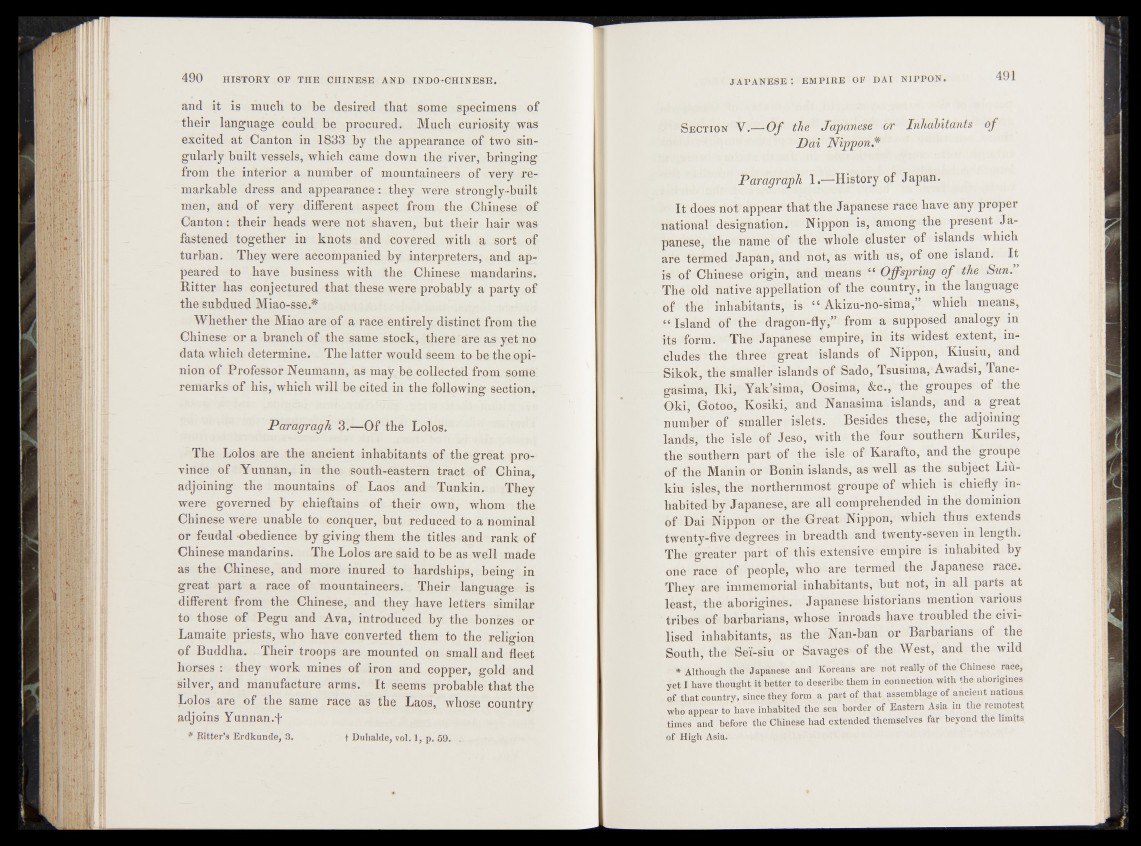
and it is much, to be desired that some spécimens of
their language coulcL bve procured. MuçJb curiosity was
excited at Canton in 1833 by the appearance of two singularly
built Vessels, which came down the river, bringing
from the inferior a number of mountaineers of very remarkable
dress and appearance r uthey were strongly-built
men, and of very. different aspect from the ; ChineseI of
Canton : their heads were not shaven, but their hair was
fastened together in knots and covered with a sort óf
turban. They were accompanied by interpreters, and ajW
peared to have business with the Chinese, mandarins.
Ritter has conjectured that these were probably a party of
the subdued Miao-sse.#
Whether the Miao are of a race entirely distinct from Jhe;
Chinese- or a branch of the same stock, Vhererare as;yèt no
data which determine. . The latter would seem to be the opir
nion of Professor Neumann, as may,be collected from j s©uîé.
remarks of his, which will be cited in the following section.
Paragragh 3.—Of the Lolos.'
The Lolos are the ancient inhabitants of the gréât province
of Yunnan, in the south-eastern tract of. China,
adjoining the ; mountains of Laos and Tunki-n. They
were governed by chieftains of their owh,: whom -the,
Chinese were unable to conquer, but ; reduced to a nominal
or feudal -obedience by giving them the titles and rank of
Chinese mandarins. The Lolos are said to be as well made
as the Chinese, and more inured to hardships, .being in
great part a race of mountaineers. t Their language is
different from the Chinese, and they have letters similar
to those of Pegu and Ava, introduced by the bonzes or
Lamaite priests, who have converted them to the religion
of Buddha. Their troops are mounted on small and fleet
horses : they work mines of iron and copper, gold and
silver, and manufacture arms. It seems probable that the
Lolos are of the same race as the Laos, whose country
adjoins Yunnan.j-
* Pitter’s Erdkunde, 3. f Duhalde, vol. 1, p. 69. ^
^ ■' S ection V .—Of the Japanese or Inhabitants of
Dai Nippon.*
Paragraph 1'.—History of Japan.
It dóes not appear that the Japanese race have any proper
national designation. Nippon is, among the present Japanese,
the' name of the whole cluster of islands which
are termed Japan, and not, as withnös, of one island. It
is; of Chinese* origin, and .means “ Offspring of the Sun.
The old native appellation of: the Country, in the language
of the^i "inhabitants,-is “ Akizu-no-sima,” which means,
“•Island Of’the dragon-fly/'’ from a supposed analogy in
its form. l%e' Japanese empire, in its widest extent, includes
thét three great islands of Nippon, Kiusiu, and
Sikok, the smaller islands of Sado, Tsuslma,-Awadsi, Tane-
gusima, m P Yak’sima, Oösima, &Cv^ the groupes: of the
Oki, GotoO, Kosiki, and Nanasima .islands, and a great
nmthher of smaller islets. Besides theses the adjoining
lands, théidsle of Jhm, with the four southern Kuriles,
the southern'part of the- isle' of Karafto, and. the groupe
of 'the Maïtin Or Bonin islands, as well as the subject Lih-
kiu isles, the northernmost groupe of which is chiefly inhabited
hy Japanese^ are all comprehended in the dominion
of Dai Nippon or the Great-^Nippon/'which thus extends
twenty-five degrees in breadth and twenty-seven in length.
The greater part of this.exteksiveoempire is inhabited by
one race of‘-people, who are termed the Japanese race.
They are immemorial inhabitants, ’but notj in all parts at
least, the aborigines. Japanese historians mention various
tribetwof barbarians, whose inroads have troubled the civilised
inhabitants, as the *Nan-ban or Barbarians of the
South, the; Seï-siu or Savages of the West, and the wild
' * Although the *'Japanese and 'Koreans dre not really-of the Chinese race,
yet I have thought, it better totdescribe them in eon,nection with the aborigines
of that country, sipce they form a part of that, assemblage of ancient nations
who appear to have inhabited the sea border of Eastern Asia .in the remotest
times and before thé Chinese had extended themselves far beyond the limits
of High Asia.